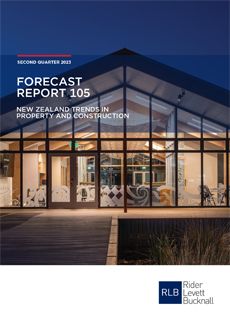According to the Rider Levett Bucknall (RLB) Forecast 105 report – New Zealand Trends in Property and Construction – there are increasing signs of slowing demand ahead, despite construction activity remaining solid for first quarter 2023.
Prepared by the New Zealand Institute of Economic Research (Inc.) (NZIER) exclusively for Rider Levett Bucknall (RLB), Forecast 105 found the decline in building consent issuance points to an easing in construction activity over the coming years, even with the post-storm rebuilding in 2024.
RLB Director, Grant Watkins said, “Indicators point to further easing in private sector construction demand over the coming years, reflecting the headwinds from higher costs and interest rates. Banks also remain cautious about lending for both residential and commercial property.”
“Although consent issuance shows a solid pipeline of construction work for the remainder of 2023, the decline in new orders and building enquiries suggests the softening in activity will become more apparent from 2024,” he added.
Construction activity to decline over the next few years
According to Forecast 105, despite post-storm rebuilding work providing some support to construction activity, RLB continues to expect overall construction activity to decline over the coming years.
Over the longer term, RLB expects the recovery in migration-led population growth will support construction demand. This is particularly the case for residential construction, as population growth drives a recovery in housing demand.
Against this backdrop of weakening construction demand, building sector firms report an easing in both cost and pricing pressures.
Grant continued, “Construction cost inflation has already started to ease from historically high annual growth of over 10 per cent last year due to this easing in capacity pressures, and we expect further easing over the coming year.”
Growth in demand for healthcare facilities, office buildings and retail outlets
Over the past year, growth in non-residential construction demand has been driven by increased demand for new healthcare facilities. Demand for office buildings and retail outlets also drove the increased demand for non-residential construction but to a much smaller extent. In contrast, demand for industrial buildings and accommodation contracted over the past year.
Growth in non-residential construction consent issuance has been concentrated in Canterbury, Waikato and Otago. In Waikato, this demand has been driven by strong growth in construction demand for storage buildings. In Canterbury, growth has been broad-based across many sectors, including social buildings, healthcare facilities and education buildings.
Meanwhile, in Otago, increased demand for the construction of healthcare facilities and office buildings more than offset weaker demand for education buildings over the past year.
Non-residential cost inflation continues to ease
The Capital Goods Price Index for Non-Residential Buildings (CGPINRB) (the Index) is an official measure of cost movements in the sector. The Index excludes GST, and we use the Index as an indicator of cost escalation.
The Index is a national average across all building types. We, therefore, advise caution in applying the increase in the CGPI-NRB as an indicator of cost escalation for specific projects.
Non-residential construction cost inflation continued to ease on an annual basis in March 2023, despite remaining steady on a quarterly basis. The 1.9 per cent increase in non-residential construction costs over the quarter saw annual non-residential construction cost inflation moderate to 9 per cent for the year to March 2023.
Continued easing in capacity pressures expected
Grant concluded, “RLB expects construction cost inflation will continue to ease from current high levels over the coming years, reflecting the easing in capacity pressures in the construction sector. The reopening of international borders has alleviated labour shortages, and supply chain disruptions continue to be resolved.”
“We expect this easing in capacity pressures will continue to reduce cost pressures in the construction sector. We forecast annual non-residential construction cost inflation to ease towards 4 per cent in mid-2024.”
“Beyond 2024, we expect a continued easing in capacity pressures in the construction sector will drive annual non-residential construction cost inflation to below 3 per cent in late 2025, before edging up slightly in the subsequent years as demand for construction recovers,” he added.
FURTHER INFORMATION:



